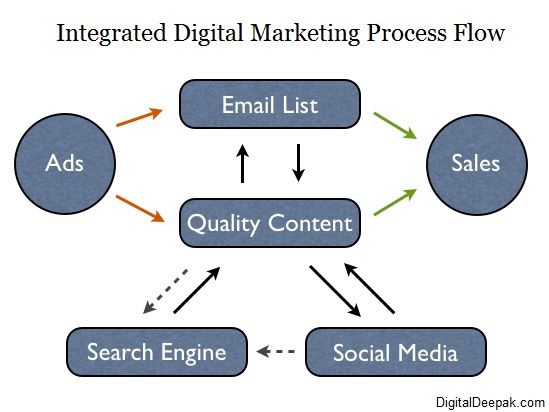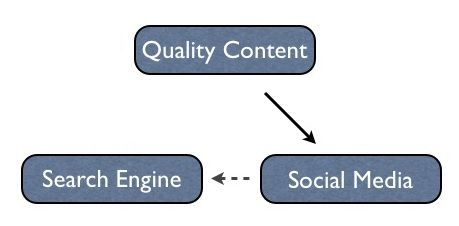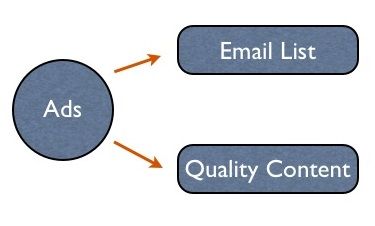Content Marketing 2.0 – How to Plan and Execute an Integrated Digital Marketing Campaign
Digital marketing has a lot of modules in it. And each module is an ocean in itself. It is pretty difficult to become an expert in every module possible. Even for someone with 10 years of experience, covering all the subjects is almost impossible.

I’ve thought a lot about this over the years. And the only conclusion that I could come to was – it is more important to execute digital marketing in an integrated way, than build expertise in each digital marketing module.
Each module such as Content Marketing, SEO, Email Marketing and Social Media Marketing is powerful on its own, but when they are combined in a unique way, it’s power goes up exponentially. It creates a snowball effect that is unstoppable.
Integrated Digital Marketing is the art and craft of using all the digital marketing methods available today in such a way that each digital marketing channel complements the other by playing it’s strengths rather than trying to reach the goal of increasing revenues and customer base on its own. Investment of time, energy and money in building an integrated digital marketing process for your business is like investing in a machinery which will magically multiply the effectiveness of each component in it.
Some of the common digital marketing methods are:
- Search Engine Marketing (PPC)
- Search Engine Optimization (Organic Traffic)
- Email Marketing
- Social Media Marketing
- Digital Display Marketing
- Content Marketing
1. Search Engine Marketing
Out of the above digital marketing methods, SEO and SEM caught the limelight in the early days of digital marketing. SEM (PPC ads) was so powerful because it helped marketers connect with prospects who are already looking for them. For example, if someone is searching for an acne cream, the ads will be only be shown to them and charged only when they click on it. This helped marketers save a ton of money because no money was wasted in untargeted ads. The reason why search engine marketing was so powerful was that it was measurable, targeted and active in real time. Due to heavy competition for high value keywords, the prices have shot up – sometimes as high as $30 – $40 per click for certain keywords such as insurance loans, mortgages and attorneys. While SEM is still effective for many marketers, a large percentage of the marketers – especially the ones in the start-up scene find SEM not longer a viable means of marketing online. When Dropbox was launched, they were spending $228 to acquire a customer who paid $99. They had to abandon SEM.
2. Search Engine Optimization
When the cost of the ads got higher because of the competition and higher bidding of keywords, marketers focused more on search engine organic traffic (SEO) because investing in SEO produced long-term returns. If you rank in the top 5 for a highly paid keyword, you would get more traffic than the advertiser who is paying so much for every click on the ad. But today “investing in SEO” has become obsolete because of the various algorithm updates by the search engines. Old school SEO methods are actually back-firing now because the search engines do not like to be manipulated.
3. Email Marketing
Email marketing was (and is) a separate wing in itself without much connection to the other digital marketing methods. The goal of email marketers was to collect leads and subscribers and send marketing messages to them. While some of the marketers still do content marketing within the emails, most of them just used email to “blast” the marketing messages. It worked for a while – until the people started getting too many emails and started unsubscribing to all the marketer’s messages which added no value to their life.
4. Social Media Marketing
As social media became famous and websites like Facebook started posting record traffic numbers, marketers flocked to the social websites for ads. But soon marketers realized that social media advertising gives a very low conversion ratio and can never be the next ‘Search’. That’s because people ‘hang out’ in social networks like they hang out in a bar and they are there to connect with their friends and to have some fun. Interrupting them with a marketing message is not effective when they are not proactively looking for a product or service like they do while searching in the search engines. But Marketers need not completely abandon social media and treat it as a 3rd class advertising option. Social media, when used in a proper manner can bring intangible benefits to the table that other channels never can.
5. Digital Display Marketing
Display ads are like ads on newspaper. They find their place between useful pieces of content and interrupt the user with a marketing message. With magazines and newspapers, the ads cannot animate and sometimes readers may even take some interest in it. But online ads are despised at best. Those animated and interactive banners distract the readers – and the very nature of internet with so many distractions built in make it a very poor branding channel. Ad blocker plugins for browsers are hitting record numbers in download volume and as people spend more time online, they develop ad-blindness. Forbes recently published an article about how display ads causes a brand awareness black hole. It should be an interesting read if you feel the same about display ads.
6. Content Marketing
Content marketing is basically an inbound marketing tactic where you attract visitors, readers and potential customers by creating good quality content. This is one of the best ways to do online marketing and it hasn’t failed anyone who has tried it. Forbes had mentioned “The bottom line is that there is only one true branding mechanism online and that’s content marketing.” I am a huge fan of content marketing and I believe that even though the world’s information is exploding, content marketing can still find its way in several markets. But content marketing won’t be effective if the other digital marketing methods are not used in conjunction with it. That’s what integrated marketing is all about. Integrated Digital Marketing is content marketing on steroids.
The Integrated Digital Marketing Process
Integrated Digital Marketing is like a team with content as the leader and the various other digital marketing methods are like its team members. Instead of asking each member to achieve the goal of increasing the company’s customer base on it’s own, Integrated Digital Marketing will make use of each member’s strengths and produce a result which are more than the sum of the individual achievements of each member.

The above flowchart describes the process of integrated digital marketing. Each one serves a unique function:
- Content: Quality and relevant content helps establish authority, build trust, engage the audience with the brand, build a tribe and spread the word with your own customers as brand evangelists. Also helps in educating the customers about the industry and your product or service.
- Email: The best communication tool available to online marketers today. Works best when used with permission (opt-in subscribers). Helps send out information about new content and follow up with the prospects to remind them about the product or service they want to buy.
- Social Media: If email is like meeting with a prospect at his home, social media is like meeting with a focus group. People are more authentic and honest with feedback and suggestions in a social atmosphere. People may not be in a mood to transact in a social environment, but it helps get honest feedback about a product or service and listen to the needs of the customers.
- Search: Helps potential customers to find your content and your offering by directly searching for it. One of the most powerful tools in online marketing and works best when you do not try to manipulate it. Doing basic on page SEO and then doing all the other things right should be enough to get truck loads of targeted traffic from the search engines.
- Ads: Paid ads in its various formats can help speed up the entire process. The integrated digital marketing process is like a catalyst for ads which maximizes the return on investment on the dollars spent.
Let’s have a deeper look at each process…
Quality Content
At the heart of integrated digital marketing is the quality content which drives the entire process. People use the internet to find information, exchange information and do transactions. Finding information is a major part of it.
When consumers want to buy something, they no longer blindly trust an ad and buy. How many times have you done that? We have burnt our fingers more than once and everyone including me do some research before buying.
The internet has just made the process easy – we can go and find reviews of products online and ask our friends in Facebook or Twitter. The most important point to note here is that before making a buying decision consumers collect data and information to help them make a buying decision.
Information comes before transaction. So instead of blindly investing money in display ads for branding and taking people to sales pages, it is much better to educate the customer about their needs, ignite their desires and then present the product or service in front of them when they naturally feel ready to buy and are convinced that you are the best one in the market.
Such information can be given to the potential customers through content marketing. Content marketing can be done via a corporate blog, a separate stand alone blog which is a publication of its own or through the various Web 2.0 properties like YouTube, HubPages, Social Networks etc. Every brand can afford to become a publisher today because the barriers of entry has been lowered and the flood gates have been opened.
Creating quality content is neither easy not free. Compared to paid advertising, content marketing may look like a free model because you are not paying for the traffic – but creating quality content costs a lot. Even having a full time writer in house to publish blog posts will cost a ton of money. But the investment in content marketing is worth it because it produces long term returns.
Many bloggers have built great blogs and believed in Build it and they will come… but the traffic never came. Marketers shouldn’t forget about the marketing part in content marketing. Content, without marketing it is of no use and that’s where all the other digital marketing methods can help.
Tips to do Content Marketing Right
- Start with keyword research and publish posts that people want to read. Give what the fish wants (worms) and not what you like (bread)!
- Do not stop with keywords. Think about other forms on content that people in your tribe may like and want to share.
- Embrace other forms of content than plain text. Videos, Infographics, Infomovies, MEMEs, Podcasts, Whitepapers, Ebooks, Kindle Books etc. can also help in content marketing.
- Make the content useful but incomplete when you want the user to take some action such as subscribing for more information. Have the hook in place. If you give away everything, there is no reason for people to connect with you. You put the worm in the hook of the fishing rod, you just don’t throw the worm into the water.
Social Media
Social media can be one of the most straight forward ways to share content and spread the word. The whole social media world is built on the concept of discovery and sharing.
If you have like minded people in your tribe in any of the social networks, sharing the links to that content on those networks will help it go viral. When people discover good quality content which can improve their personal or professional lives, they are compelled to share it again with their network so that their friends will thank them for it.
People gain good karma points when they share good quality content with their peers. Poor content or even just mediocre content will not be shared by people and that why I emphasize the word quality when talking about content.

If you are reading this right now and if you have a friend who may find the concept of integrated digital marketing useful, you are more likely to share it with her. If I post content just for the sake of it, it will just stay in the blog and nothing will happen. As content is shared in the social media, new followers or tribe members can be gathered through the spread of information and those new members will come back to the blog when some fresh content is published. As shown in the above figure, content and social media can have a symbiotic relationship.
Social media can be an uphill or or a downhill ride depending on the quality of the content. Really good content is key to an effective social media strategy. A good piece of content when shared in social media will have a snowball effect. You can use your social profile just to kick start the discovery and sharing process.
Some tips to use Social Media effectively
- Integrate social sharing buttons into the content seamlessly. People will not hunt for the sharing buttons in most of the cases, but when it is right in front of their eyes, they are more likely to share it. Have sharing buttons in the side of the blog posts and also at the bottom of the posts.
- Be active on social media profiles. Engage with the users. Social media is a big listening tool than a broadcasting tool. Ask for suggestions for new posts and respond to questions in social media. If you are more active in Facebook, for example, your edge rank will be higher and it will help reach more people from your fan page.
- Have a well designed social media profile. YouTube, Facebook, Twitter and almost all the other social networks give options for customization and it doesn’t cost more than a $100 to get a good designer decorate your profile. People can instantly differentiate between channels which care about their followers and those who don’t.
- Use paid advertising inside the social media websites to increase followers and engagement in those websites. For example, using Facebook you can increase the fans to a fan page using Facebook ads which usually gives a very high conversion rate than using Facebook to drive traffic out to your website.
Search
For many businesses, traffic from the search engines contribute to a large percentage of their revenues. Before the search engines became smart, people used to “invest” money in SEO by hiring an SEO agency and have them do back-linking and other optimization activity on their website. Such practices no longer work because Google is very smart in determining the low quality and manipulative link building activities and there are virtually no SEO agencies who can do SEO the way it has to be done – it can be done in the right way only by the owner of the website. The right way is link earning and not link building. When good content is published and shared on social media it has the potential to attract natural links and that’s off page SEO at its best.

Search engines rank websites according to their quality and relevancy. The quality and relevancy of a certain web page for a certain keyword is determined by two factors.
- One factor is the on-page SEO where the webmaster communicates to the search engines about the quality and relevancy of a website.
- The other factor is off-page SEO where the users of a website communicate to the search engines about the quality and relevancy of a website.
Though on-page SEO is an important factor in SEO, there is only so much you can do in on-page optimization. You can have your web page elements in such a way that the search engines can understand what your content is about. But since webmasters have a bad history of communicating with the search engines about what content they have, on-page SEO has a limited potential to convince the search engines that your content is quality and relevant to certain keywords.
In Off-page SEO – the users of a website communicate to the search engines about the quality and relevancy of a website – not directly but through their behavior. In the above figure you can see that the search engines send some traffic to the content but at the same time the content sends back signals to the search engines about the quality – through user behavior. Some typical examples of user behaviors communicated are time spent on the site after a search result is clicked. If a user immediate clicks the back button after clicking on a search result then it is obvious that the content on the website is either of low quality or not relevant.

Apart from the signals picked up by the user behavior, search engines also pickup signals from the social media. Quality content when shared on social media is public information and open for the search engines to pickup. It is an obvious signal that the content quality should be good. Off page optimization takes care of itself when the basic necessary on-page optimization is done, quality content is published and a social strategy is executed properly.
Tips for Search Engine Optimization:
- Do on-page optimization for your website according to the guidelines set by the search engines. Google, Bing and Yahoo have their web master tools which can help you in on-page optimization. Tools like SEOMoz can be a life saver when you need suggestions to improve your on-page optimization. Content management systems like WordPress are optimized right out of the box.
- Off-Page SEO optimization is a mis-nomer. You cannot off-page-optimize a website. There are only off-page signals and those signals have to be sent by your users and not you. If you try to send fake signals on behalf of your users, then you will be caught by the search engines sooner or later and penalized. Publish good content and share it. Have a good out-reach strategy so that your website / brand gains value in the market place.
Email marketing is one of the most powerful tools available to an online marketer today. Emails are around since the beginning of the internet and people will always use emails till the world ends. An email inbox is a personal space and unlike social networks it is not easy to interrupt an Internet user with a marketing message. But with a permission based email list where people have opted-in to receive communication from the sender, the email subscriber will open an email and pay her attention to the message.
Email marketing is effective only when a mix of useful content and marketing messages are sent alternatively. If you bombard the subscriber with too many marketing messages, the user will unsubscribe. If you send no marketing messages at all, you can’t make any profits.

So how can we fit email marketing into the integrated marketing strategy? What do you need to do email marketing effectively? You need qualified leads/subscribers. These subscribers when engaged in a proper manner can turn into long term paying customers. Usually email marketers gather leads by advertising in other channels. But when you have your own content channel, you can use it to gather subscribers. A lot of niche bloggers have been doing this effectively by using tools such as subscription boxes, popup forms on the webpage and co-subscription with comments section of the blog.
Instead of sending out useful content to the email subscribers, you can publish that content on the blog and email your subscribers a link to that page. When subscribers visit that blog post article, they are very likely to share it on social media and check out your products/services again. Also this piece of content on the blog has the potential to attract new visitors from search and social media and those visitors may become subscribers as well.
A large percentage of subscribers can come via the search engines when the strategy is optimized and refined. This can reduce the cost per acquisition of a customer drastically thus helping you make more profits in your business.
Email Marketing Tips
- Optimize lead generation on your content delivery channels. A lot of tools are available in the market place which helps you collect leads through blogs, videos and so on.
- Use email marketing tools such as Aweber, MailChimp, GetResponse to automate your email marketing process. Amazon SES and SendGrid are good email sending servers for the technically inclined.
- Send a mix of marketing messages and valuable content. A good balance depends on the tolerance level of your market. Test, test, test.
Paid Ads
Paid advertisements, whether it is digital display ads, social network ads, co-sponsored email ads or PPC ads on search engines – all have a good potential to ignite and speed up the entire integrated digital marketing process. Instead of using paid ads to directly jump to sales, the traffic from the ads can be channeled into content which will help build trust and educate the prospective customers and in turn increase social media activity, search traffic and email subscriber list.

The Search-Social-Email trio along with powerful content is like a magic machine for the paid ads which increases the ROI on ad-dollars spent and also gives intangible benefits like building a tribe or community. A tribe helps in improving the product offering, generate ideas for new products and sometimes can even double as a free support group and a team of evangelists.
Driving the Sales
No one buys a product on the first look. Impulsive buying for many products is far and in between. The general consensus is that it takes an average of 7 points of contact with a prospect to turn her into a customer. With Digital marketing, the best way to turn a prospect into a customer is to followup with the lead. The lead data can be an email, a phone number or both.

Email marketing is the most cost effective tool available to marketers today and with automated marketing tools like MailChimp and GetResponse, it is easy to setup a sequence of automated messages to be sent to a prospect once she subscribes to the email Newsletter.
A subscriber will open the emails and visit the blog only when there is some useful content and a sale can happen directly by clicking on an email link or a link from the blog. The email newsletter and the blog are the primary value delivery platforms and the conversion is more likely to happen in this case.
Conclusion
The above integrated digital marketing process effectively utilizes all the digital marketing technologies available today and in such a way that the strengths of each method is used in the most effective manner. Content marketing always has been and always will be one of the most effective lead generation, branding and sales channel and this process is simply enhancing/upgrading the content marketing to the next level. And that’s why I call this integrated digital marketing process as Content Marketing 2.0!